In Part 9, we had just arrived at the Jonestown / Hershey NE KOA campground. Then, we’d gotten the trailer ready for the night, refuelled the truck, and gone to bed. We’d seen plenty of evidence that COVID-19 was now being taken seriously. Now, it was our last day of the trip–we expected to arrive at home early in the evening.
At the Jonestown / Hershey NE KOA campground, the store and office retail areas had been closed due to COVID-19. All business for both was to be conducted through their takeout window. Fortunately for us, this allowed the campground to remain open.
COVID-19 Status
As of the end of the previous day, March 18th, the cumulative COVID-19 case count in the USA had risen to 8,074, a 43% rise from the previous day. The number of deaths attributable to COVID-19 had increased to 123, a 27% increase from the previous day. As this exponential increase continues, the counts are likely to get far larger in the coming weeks.
Winterizing the Trailer
Although the day before had been a long one, we had gone to bed not long after arriving in the campground. So, we were both up shortly after 7:30 am. We had breakfast and then we got ready for the day. It was time to winterize the trailer.
We have to winterize the trailer because back home in Ottawa at this time of year, it often goes down below freezing at night. So, we have to drain the tanks and all water lines to prevent the freezing from causing damage. We also pump RV antifreeze through the lines and put some in the grey tanks and the black tank.
If you make a mistake winterizing the trailer, something usually gets damaged when any water freezes. For that reason, it’s important to have a checklist. There is a video guide to winterizing your trailer available at the website of our trailer’s manufacturer, Keystone RV. This is meant to cover their product line of trailers and so there are instructions for trailers that have systems like this and instructions for trailers that have systems like that. For the sake of simplicity, I produced my own checklist that left out the irrelevant parts. I also added a step that they didn’t cover–their procedure turns on the hot water tank bypass before blowing out the lines, meaning that the line from the hot water tank bypass valve to the hot water tank isn’t blown out. So, I added a step for that.
Our Trailer Winterizing Checklist
- Disconnect the water hose from the trailer.
- Drain the hot water heater.
- Empty the fresh water tank, the black water tank, and both grey water tanks.
- Run the water pump for 30 seconds to drain the feed line from the fresh water tank. Open a faucet to allow this water to drain into a bucket.
- Drain all lines, opening all faucets, via the low-point drain valves. Don’t forget the toilet and the rough-in for the washing machine. Close the faucets afterwards.
- Blow out the black water tank flush system using our compressor set to less than 30 psi.
- Connect the compressor, still set to less than 30psi, to the city water inlet and blow out the line leading to the hot water heater. You should be able to feel air coming out of the hot water tank’s open drain plug.
- Bypass the hot water tank to avoid filling it with RV antifreeze in a later step.
- Put the drain plug back in the water heater and return the pressure relief valve to its normal position.
- Blow out all lines including the inside and outside showers, both hot and cold. Open one line at a time. Don’t forget the toilet and the rough-in for the washing machine.
- Close all tank valves. Reinstall drain caps, including the fresh water drain cap.
- Pump RV antifreeze through the system, ensuring it appears at each opening. Remember the inside and outside shower hot and cold taps, the toilet, and the washing machine lines.
- Pour RV antifreeze into the grey tanks and the black tank. Remember to leave some in the toilet bowl to protect the seal.
- Encase the toilet seat in a plastic grocery bag to remind us not to use it.
- Put tape over the switches for the electric and propane water heating and the water pump so we don’t switch them on accidentally.
Fresh Water Tank
You may recall from Part 8 that we had drained much of the fresh water tank at a rest area. When we’d arrived last night, I’d opened the fresh water drain valve and let the fresh water drain onto the campsite. We didn’t have much fresh water left so that didn’t take long.
Final Preparations
With the trailer now winterized, there were still a few things for us to do, COVID-19 or not. We got the trailer ready to travel, stowing stuff and rigging doors to stay closed during the trip. We also retracted the slide-outs.
Because we had travelled from warm weather in Florida to cool weather here, the trailer tire pressures had dropped. While our air compressor was out for the winterizing process, I used it to top up the trailer tires, bringing them up to the 110 psi that they require.
Then, we coupled the trailer to the truck, locked the fifth wheel release lever, connected the trailer electrical cable to the truck, and also connected the trailer brake emergency disconnect cable to the truck. Finally, we retracted the landing gear, confirmed that the trailer lights were operating properly, and performed a walk-around inspection of the rig. We were now ready to depart. Before we did so, I took a few pictures of our campsite.
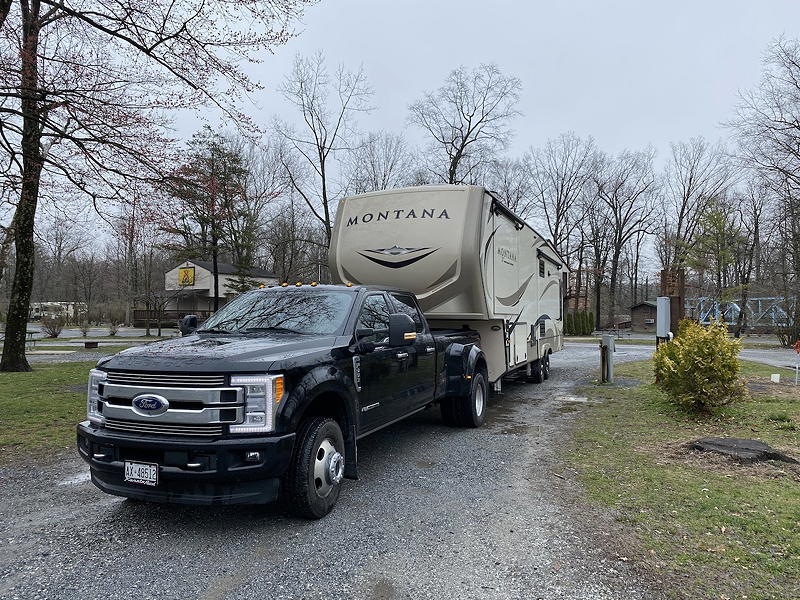
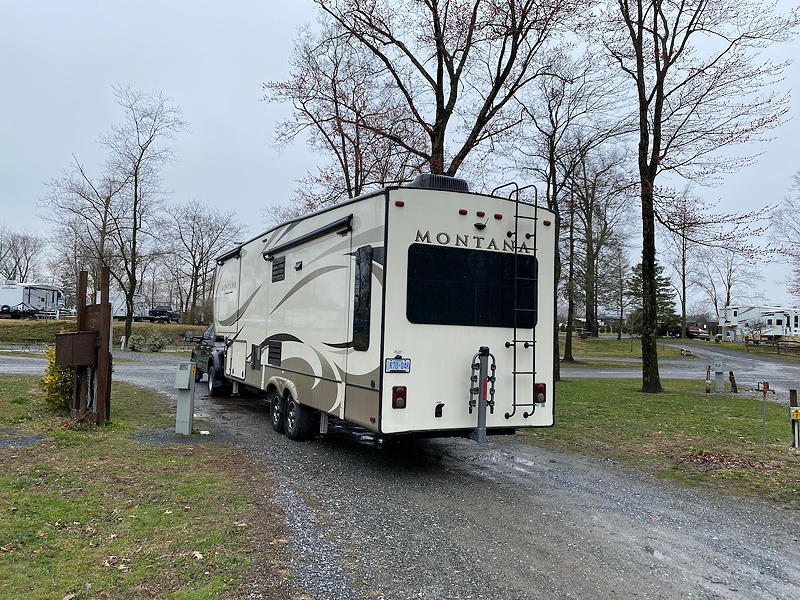
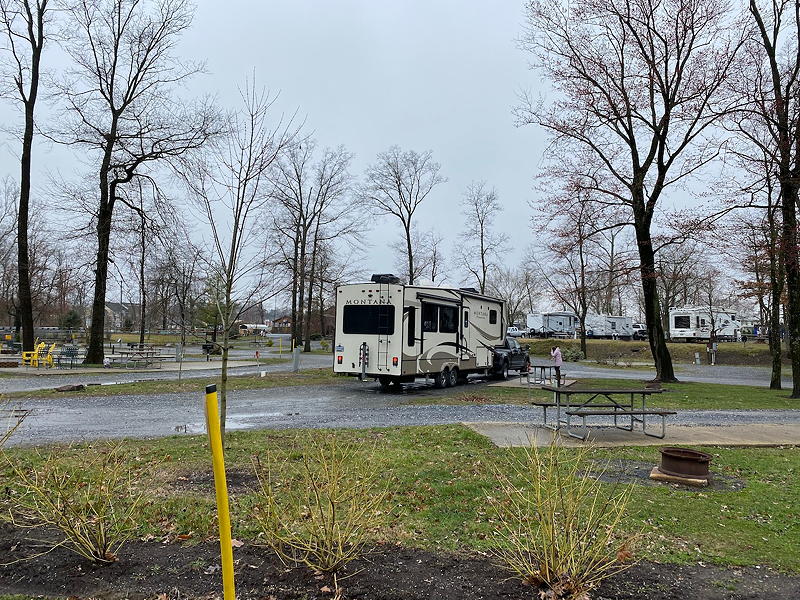
Heading for Home
We were finally ready to leave the campground just after 10:35 am. We had hoped to be on our way by 11 am, so we were pleased to be a bit ahead of schedule.
On our way home, I planned to stop, once again, at the My US Address warehouse in Ogdensburg, New York to pick up a package I’d ordered during our trip. So, both navigation units were programmed with that destination as a waypoint.
Once again, the Pennsylvania rest areas were closed, except for one. Of course, we didn’t need to stop when we passed the open one. We had hoped that they were all open now, but the rest we passed were closed. Instead, we had to find another place to stop for a bathroom break and to eat lunch. Joanne found an Exxon station in Harford Township, Pennsylvania, and we stopped at about 12:45 pm.
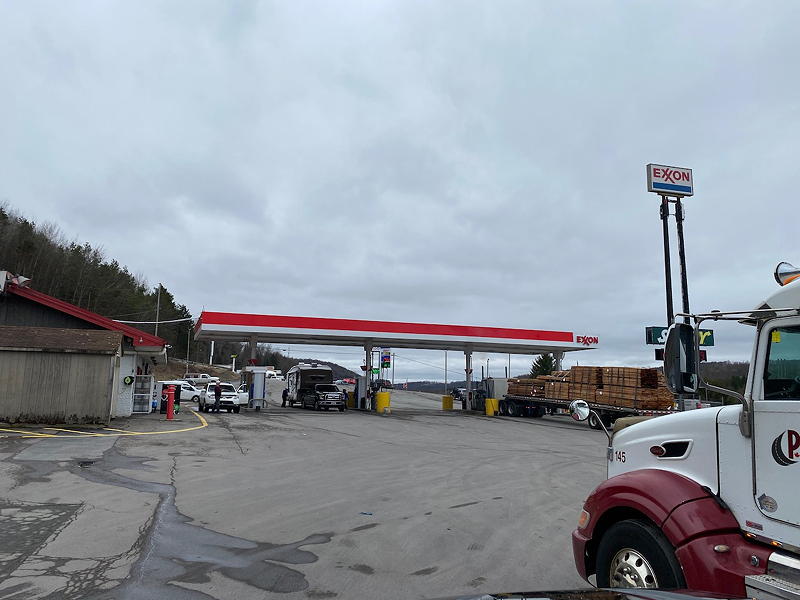
Normally, we would make it all the way home on one tank of fuel. However, we weren’t sure how long it would take to cross the border. So, we had decided to refuel at some point. However, the fuel here was $2.819, the highest price we’d seen for diesel on this trip. With New York coming up, we figured we’d wait until then.
Refuelling
At about 2:20 pm, we stopped at a Pilot Travel Center in Liverpool, New York for diesel fuel. I inadvertently entered through the tight entrance for cars. Fortunately, I managed to get through the curved ramp without making any contact with our tires. The station was roomy despite us being at the automotive pumps. However, the price was shocking at $3.199 for diesel. This was by far the most we paid for diesel fuel on the entire trip. In hindsight, we would have been much better off refuelling at our Pennsylvania stop.
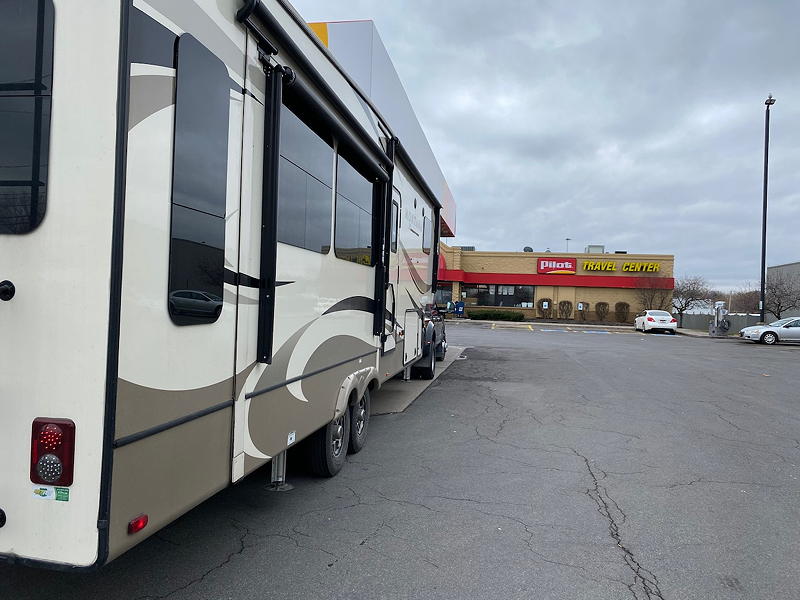

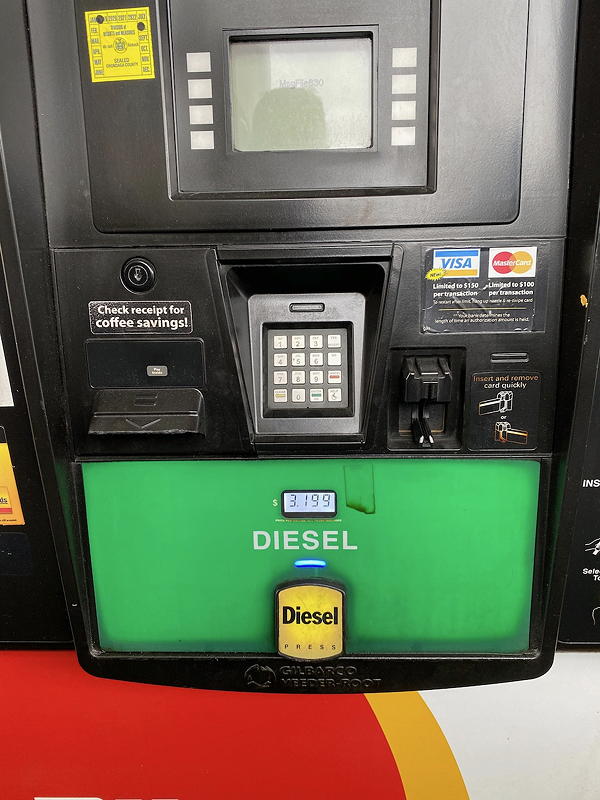
COVID-19 Signs
On our journey on I-81 in New York, we saw dozens of portable signs at the side of the highway telling people to stay home. They seemed to be everywhere. There were large signs that alternated between Stay Home Stop The Spread and Save a Life. There were also smaller signs with a similar message. Of course, New York was hit early and hard by COVID-19 and it was clear that they were really trying to get people to self-isolate to reduce the spread of the disease.
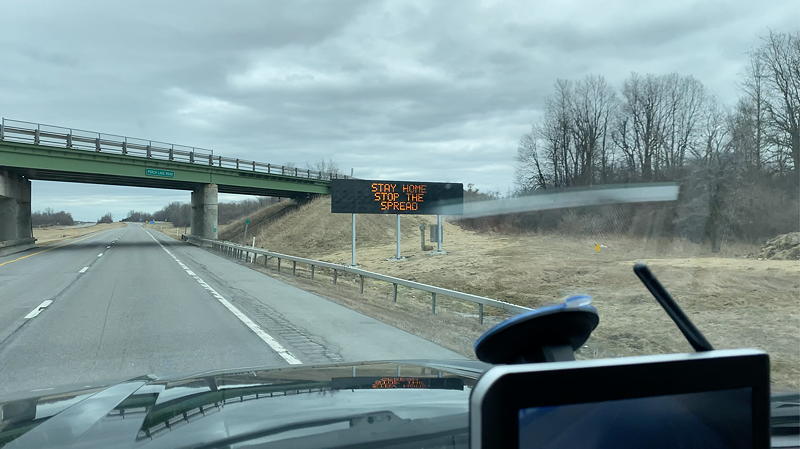
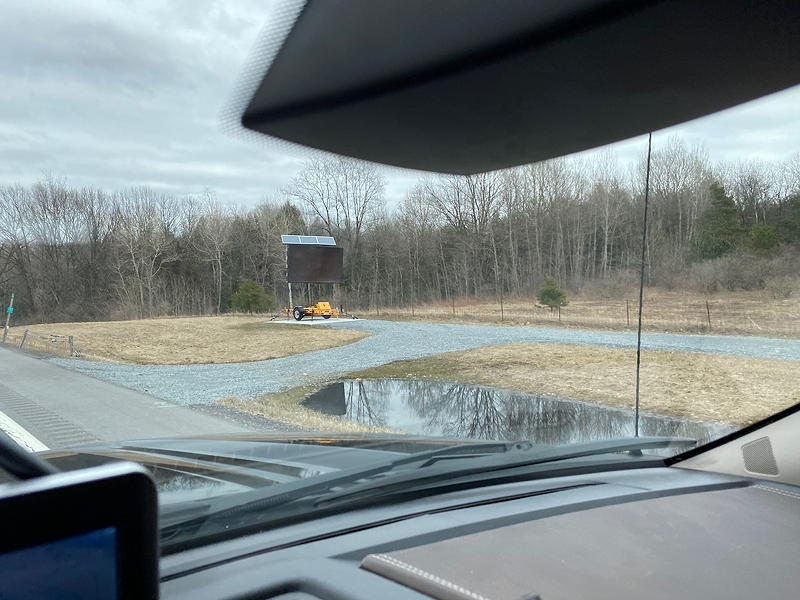
Arrival in Ogdensburg
We finally arrived in Ogdensburg at about 4:00 pm. We weren’t sure how long the lineup would be at the border, and since we wouldn’t be able to use the winterized bathroom in our trailer, our first stop was at a Tim Horton’s plaza in Ogdensburg for a bathroom break.
My US Address and COVID-19
With the bathroom break out of the way, we headed to the My US Address warehouse. Once we got there, I went to the door but they were closed. Although they should have been open until 6:00 pm, they had closed due to the COVID-19 pandemic. I couldn’t get my package, which meant that I couldn’t benefit from our duty-free / tax-free exemption due to our two week stay in the USA. Also, since the border would shortly be closing to non-essential traffic, I wouldn’t be able to come back later until the border was re-opened.
I did have one option remaining. They have a Push It North service that ships your package to you in Canada for a price of $20 for customs clearance and $9.95 for shipping. That amounts to about ten percent of the value of the package, so I may do that eventually.
Disappointed, we left My US Address and made the short, five-minute drive to the bridge toll booth, paid the USD$10.25 toll for our rig, and then crossed the bridge to the entry point to Canada.
Crossing the Border
Joanne had been checking a website for delays at the border. Although the main Thousand Islands crossing at Hill Island was showing a delay of an hour, the Ogdensburg crossing delay was listed as having no delay at all. Unfortunately, by the time we got over the bridge, it was obvious that we were going to be in the line for a while.
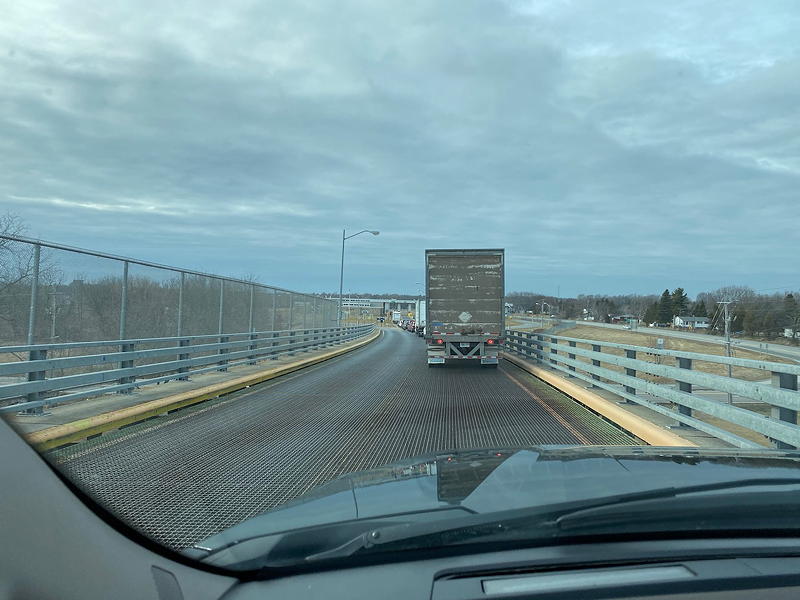
The line was about twice as long as any line we’d been in at this border crossing. We’d never joined the line while still on the bridge, as we had in this case. Typically, there are five to ten cars ahead of us, and we had far more than that this time. We could see that this was going to take a while, especially since there was only one lane open at the border.
As we sat in line, we would advance every minute or two. As we did, a couple more vehicles would join the line behind us. The line was steadily getting longer. Then, when we were about half way to the crossing, the line started moving three times faster. There was still only one lane open, so we weren’t sure why we were suddenly moving much faster.
At The Border and The COVID-19 Effect
Finally, we got to the head of the line. Usually, we are asked how long we’ve been in the USA, which determines our duty and tax exemptions for this trip. Then we’re asked the value of goods we’re bringing back and whether we have any alcohol or tobacco with us. There can be a variety of other questions, but those are the main ones. Then, since we usually have goods to declare, we may be asked to show receipts for the goods, which I always have at hand. This time, it was very different.
With COVID-19 driving Canadians to return home, and with the Canadian Prime Minister, Justin Trudeau, having urged Canadians to return home, the number of people trying to cross was much higher than usual. When we got to the border guard window, the person on duty asked us three health questions related to COVID-19. Then, he handed us a double-sided information sheet about COVID-19. Next, he very politely, but firmly, told us to self-quarantine for fourteen days. Finally, he welcomed us back to Canada.
The COVID-19 Information Page
The front of the COVID-19 information sheet has a list of instructions for self-isolating and monitoring your health. It also had a list of instructions if you started exhibiting symptoms.
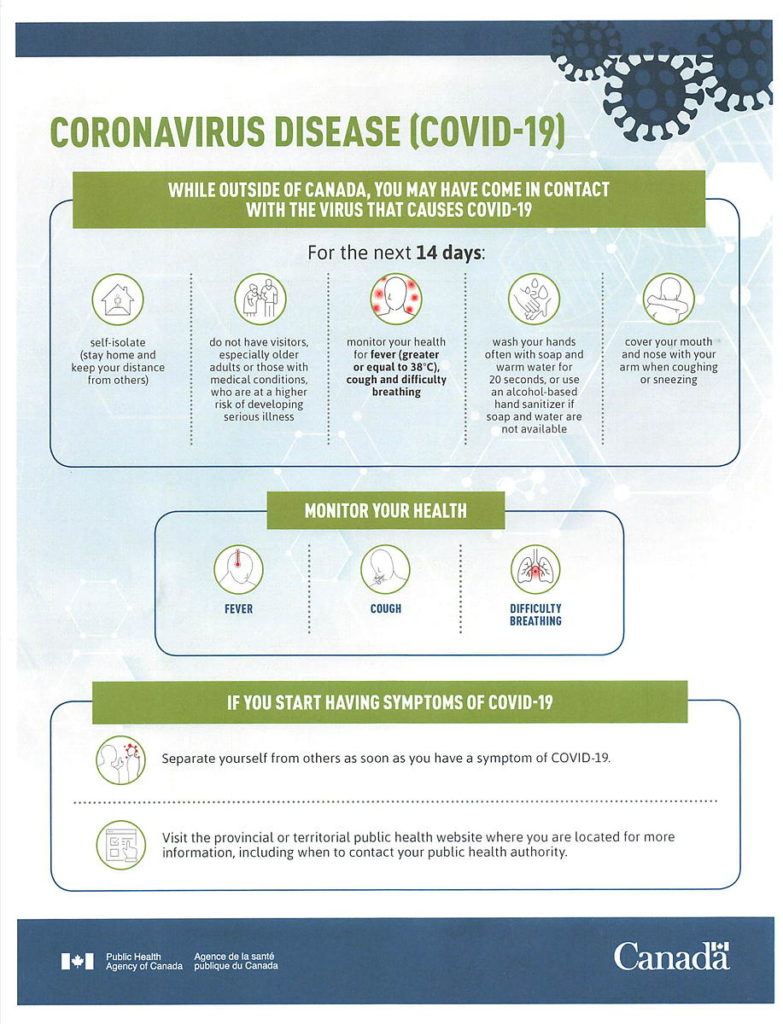
The back of the information sheet had a list of steps for preventing COVID-19 infections as well as a list of telephone numbers and websites for the provincial and territorial health authorities. Lastly, there was a reference to the Government of Canada information line and website for COVID-19.
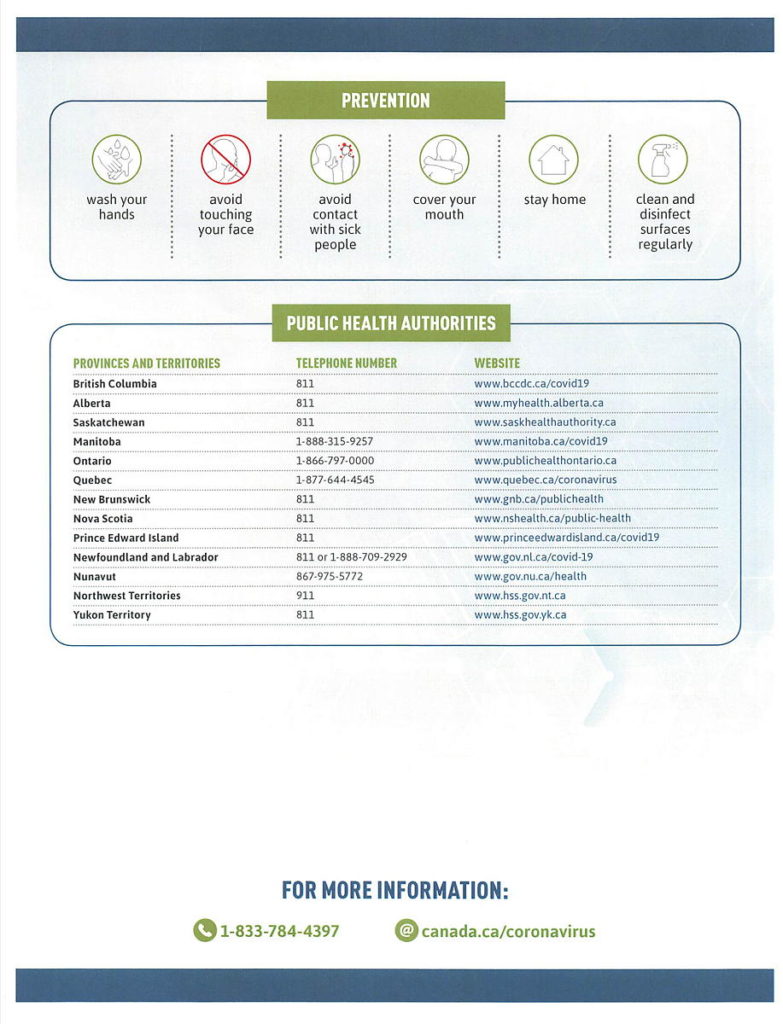
Leaving the Border
The border guard had seemed tired. Despite that, he seemed to feel that we were all in this together. I was surprised at the lack of the usual questions, but I’m guessing that they looked at the increasing length of the line and decided to dispense with routine. Instead, they focused on the most important thing–the health of the returning Canadians, and the advice in the one-page information sheet. We were grateful for the suddenly faster line.
In the end, it took us thirty-one minutes from joining the lineup until we were pulling away from the border guard station. Not as short as we’d hoped, but nowhere near as bad as we’d feared. Overall, we were fairly pleased with how it had turned out.
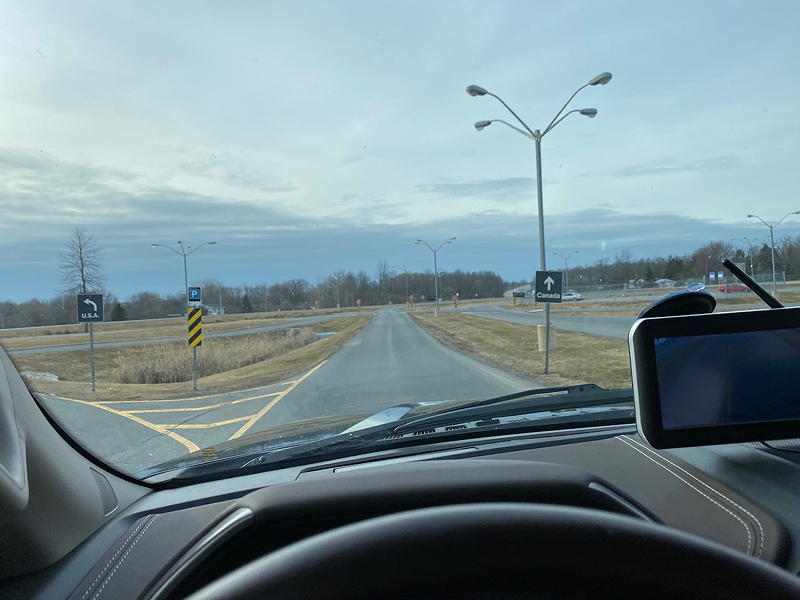
COVID-19 and Traffic
With the entry into Canada, we still had a 45 minute drive to get home. We were soon on Highway 416 on our way to Ottawa, where we would pick up Highway 417. Traffic was quite light. Nevertheless, we were shocked when we got to the ramp onto Highway 417. There was almost no traffic at all!
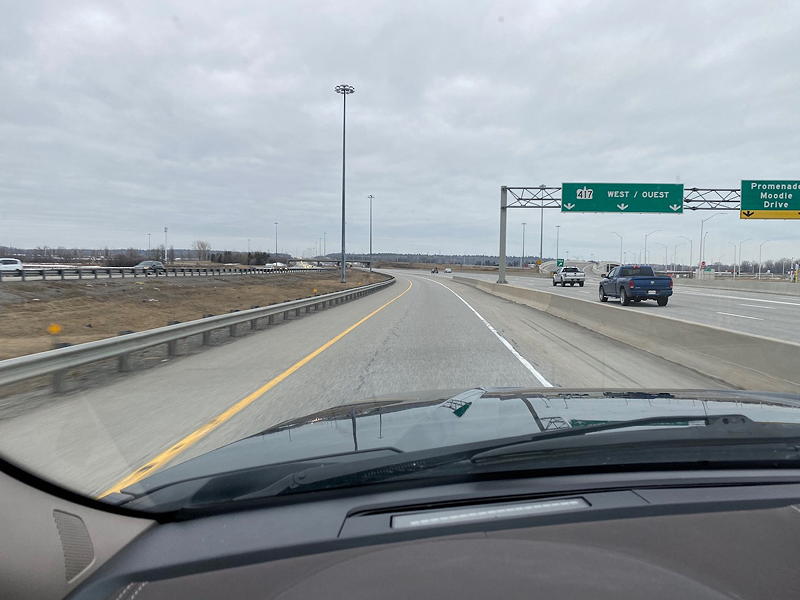
Normally, at this time of day on a workday–and we were arriving on Thursday–there should be bumper-to-bumper traffic and brake lights all the way as far as you can see. The traffic is typically moving slowly, but steadily, at about 40 km/h (25 mph). Here, there were hardly and cars at all. Clearly, the people in Ottawa were taking the Stay at Home mantra very, very seriously. This was helped by a lot of organizations, including most of the high-tech companies in this part of town and the Canadian Federal Government, directing their employees to work from home. As the capital of Canada, Ottawa has a lot of Federal Government employees.
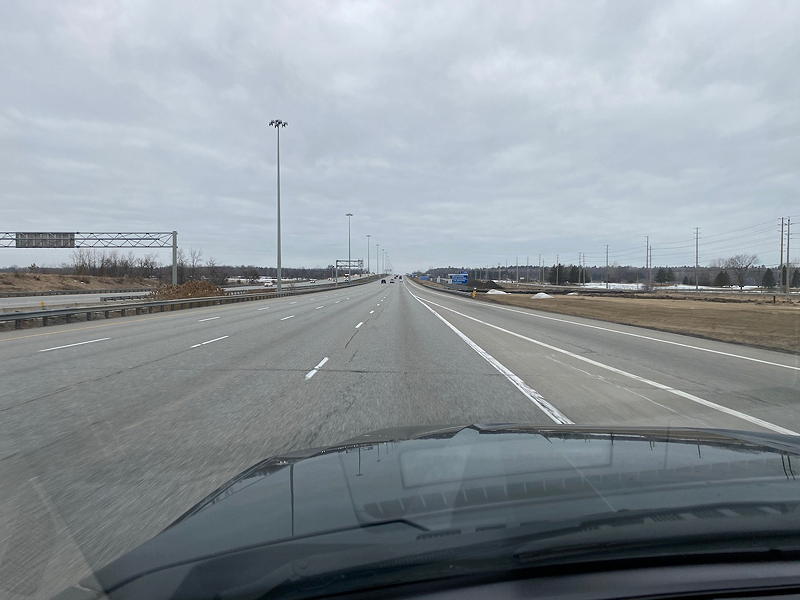
March Road
Finally, we arrived on March Road on our way to our house. Even here, there is almost no traffic. At this time of day on a workday, traffic should be bumper-to-bumper and stop-and go. Obviously, that wasn’t the case here. This part of Ottawa–Kanata to longtime residents of the city–is home to a large part of the high-tech industry in Ottawa. That industry, of course, generally has a fairly easy time at supporting working from home. Presumably, that’s why we had so little traffic here.
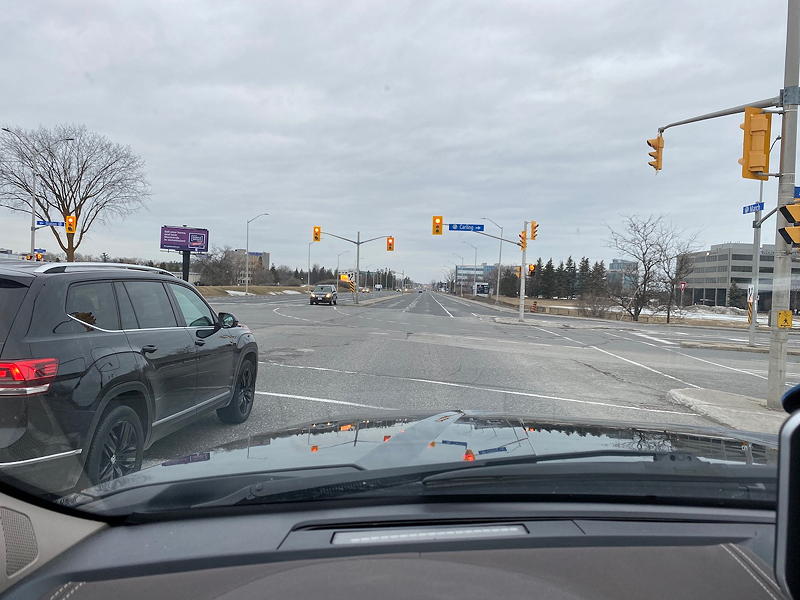
Contrast to USA
This lack of traffic stood in stark contrast to our experience in the USA. During the journey home from Florida, we’d covered a lot of miles on the road and we’d seen no evidence of a significant drop in traffic volumes. Granted, we bypassed Washington DC via I-81 and we’ve only been on that part of I-81 a few times. So, yes, the traffic volume might have been down 25% and we might not have known it. However, there was nothing there like the empty highways we saw once we were back in Canada.
Arrival at Home
We finally arrived at home just before 6:30 pm. We’d left at about 10:35 am so the journey from Jonestown had taken us just under eight hours. We were pretty pleased with that.
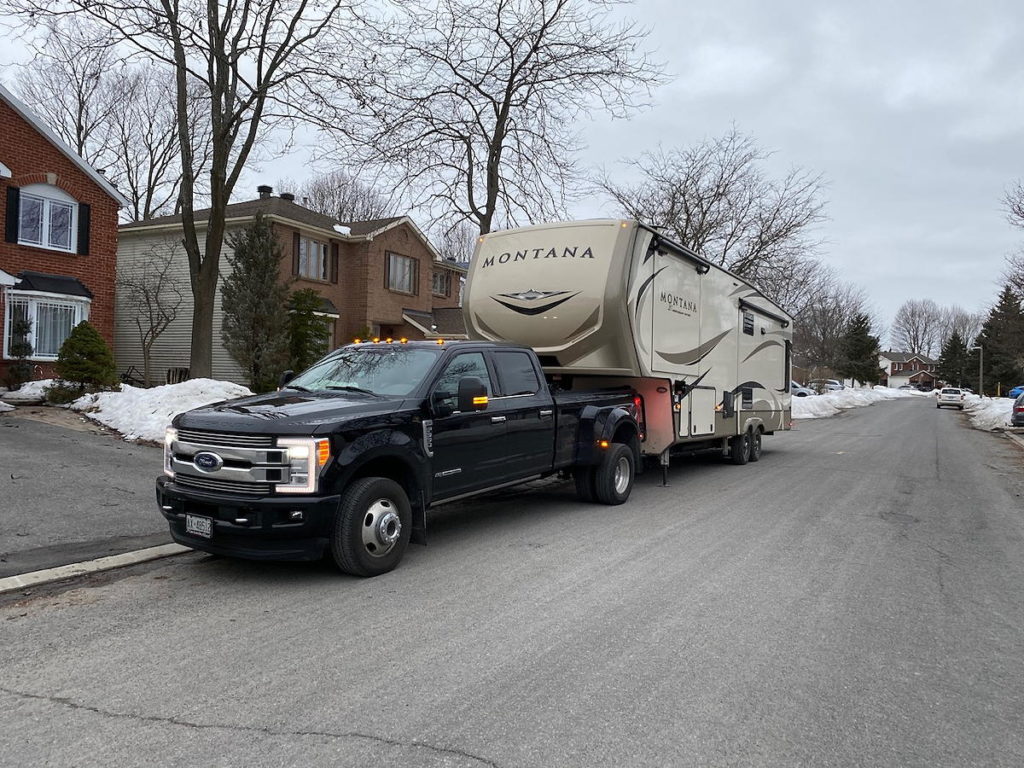
Because we were back home two and a half weeks earlier than we had planned, there was a lot more snow left for us to enjoy. We couldn’t get right up against the curb because of the snowbank. However, we were within about a foot of it, which was close enough. Then, we uncoupled the truck from the trailer and auto-levelled the trailer.
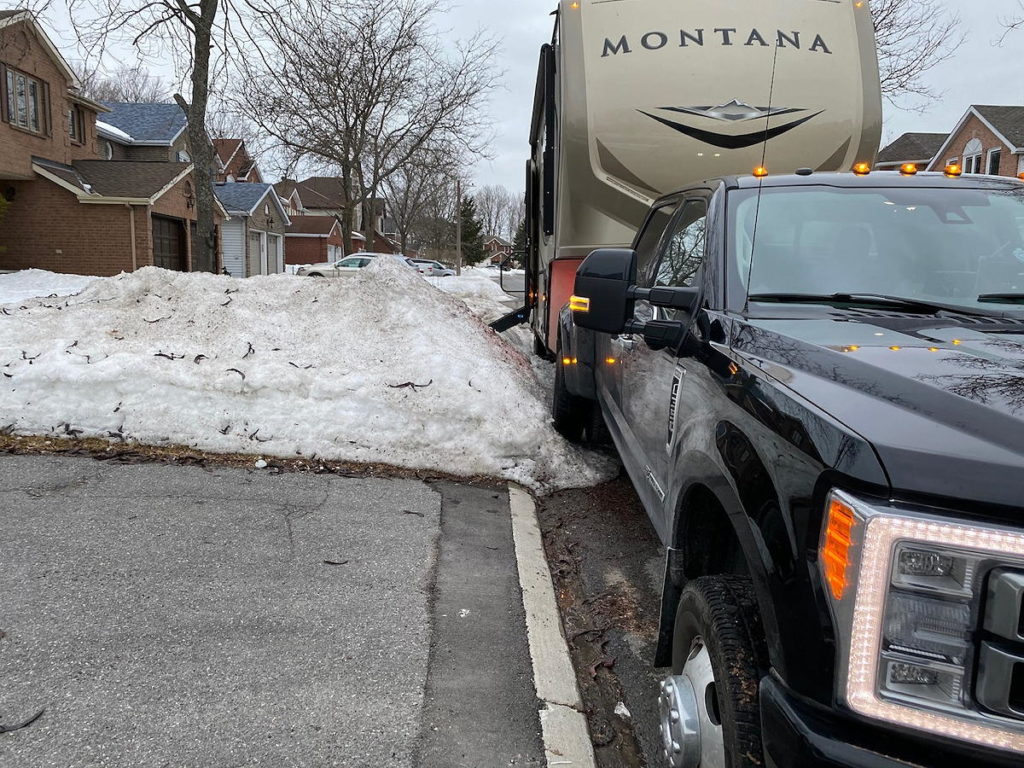
The Joy of Snowbanks
The snowbank, of course, interfered with the lowering of the stairs of the trailer. We had to dig out part of the snowbank so that we could get into and out of the trailer without crossing a nearly-horizontal set of trailer stairs. Despite that, the stairs were not low enough to close the trailer door. The door would have hit the top of the stairs and could not have passed over them. However, we didn’t want to dig the snowbank much more than we did or else we would have had to step up off the bottom stair to get up onto the snowbank on the way to the door of our house.
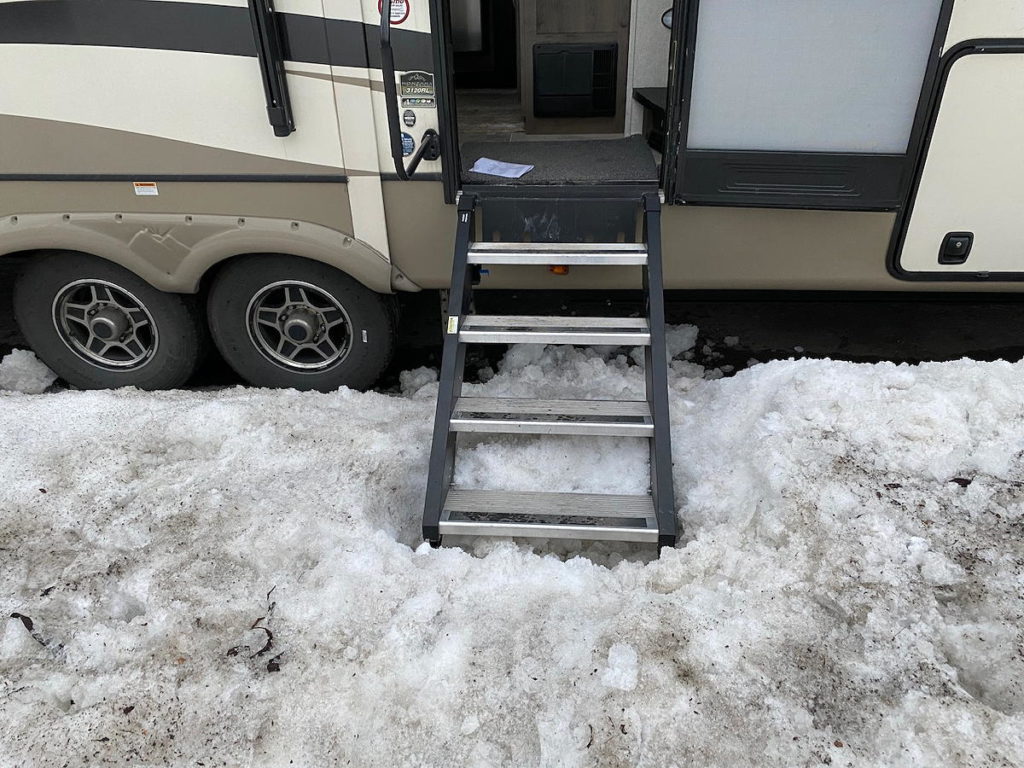
Because of where the stairs landed, we had to trudge across the remainder of the snowbank and the snow on our front lawn to get to the front door of our house. That pathway became pretty packed down after we unpacked the trailer.
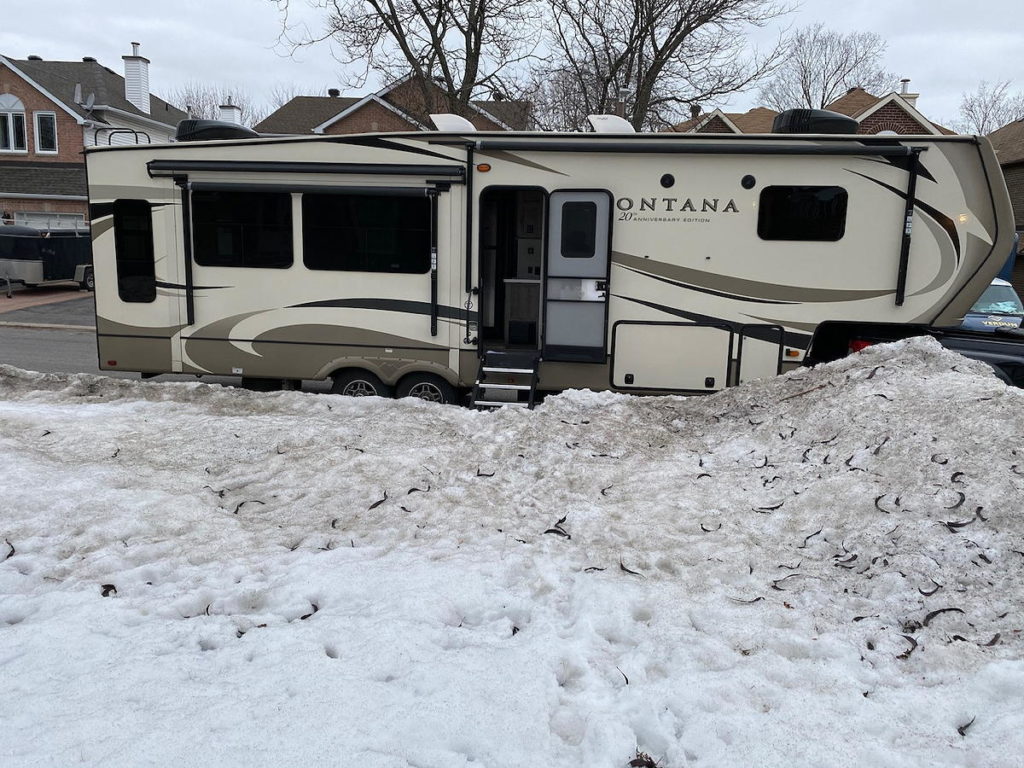
Slide-Outs
To unpack the trailer, we have to extend the slide-outs. We have gear in wall-mounted cabinets above the back window of the trailer. To get to them, we have to open the curb-side slide-out. Otherwise, we’d have to crawl underneath the kitchen table. The slide-out on the other side blocks access to the kitchen cupboard, so we definitely needed that open. Finally, the bedroom slide-out blocks access to the dresser and the clothes closet. So, all of the slide-outs had to be extended.
Because of the snowbank, we had to very careful opening the curb-side slide-out. Joanne stood careful watch while I operated it. Fortunately, the slide-out cleared the snowbank–barely. Otherwise, we would have had to dig out more of the snowbank.
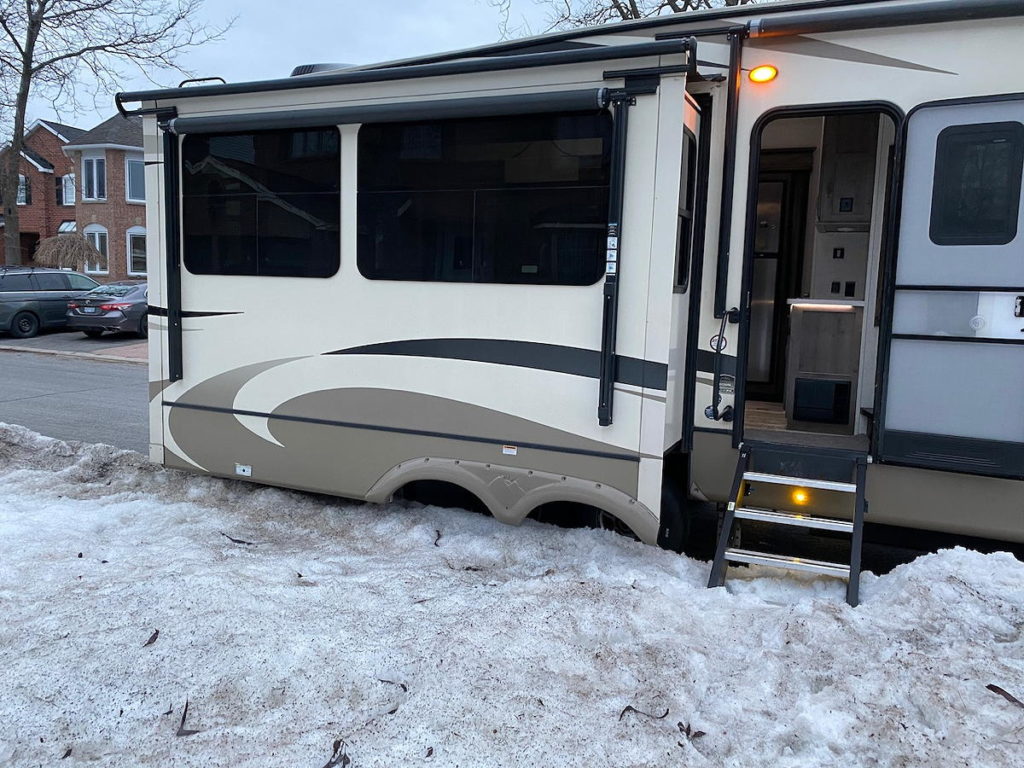
In the picture below, you can see that although we’re as close to the curb as we can get, the curb-side landing gear was on top of ice. Fortunately, we were planning to take the trailer back to the storage yard the very next day. So melting of the ice under the landing gear shouldn’t be an issue.
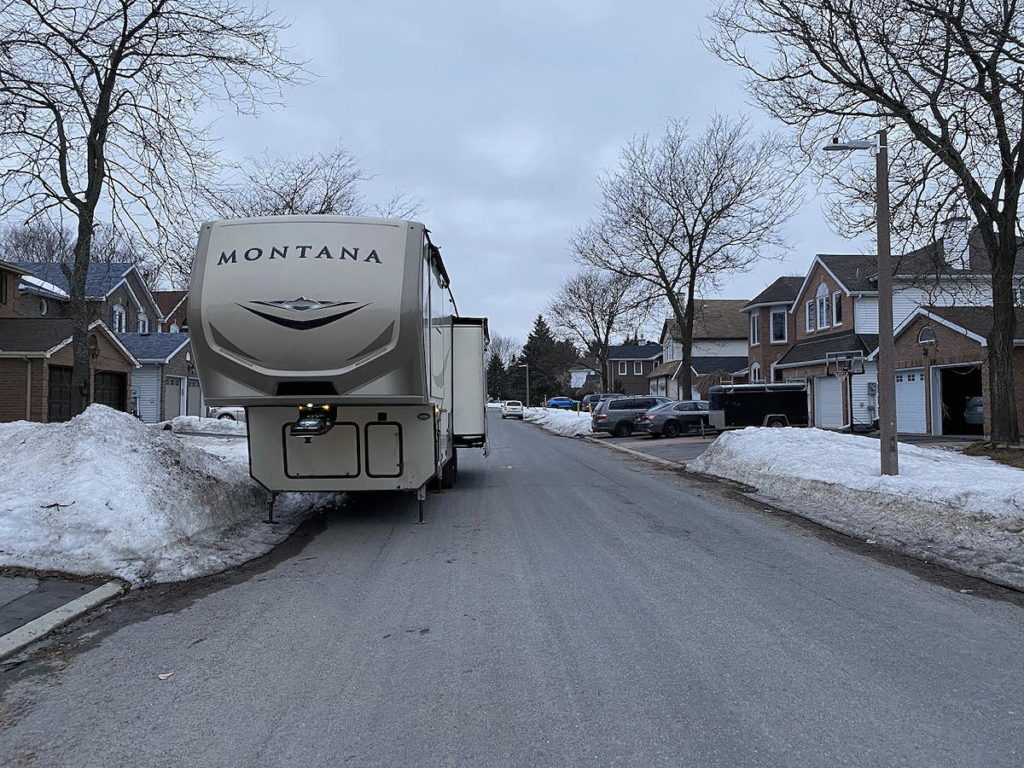
With the slide-outs extended, the trailer is almost half the width of the road. If anyone was to park against the curb on the other side of the street, they’d block traffic from passing through. For that reason, we don’t like to have the slide-outs extended for more than an hour or two. It’s not quite as bad in the summer when the trailer can be a foot closer to the curb.
Unpacking
With the trailer finally set up and the stairs opened, we were able to begin unpacking the trailer. Because it’s still going below freezing at night we had to remove anything that would be harmed by freezing. We also removed any gear that wasn’t a permanent part of the trailer. Food, clothing, bass guitars, and various sundries were taken out. It took about two hours to get that done but finally we were able to get the stairs back up and trailer locked up for the night.
Driving Time and Distance
The truck has two “trip odometers”. I use one for tracking the distance of each leg of the trip. That way, I know the overall distance that the trailer travelled for each leg. It also lets me track when certain maintenance items such as brake maintenance and bearing maintenance have to be done.
I use the second “trip odometer” to track the overall statistics for the entire trip. This includes when we’re not towing the trailer, such as when we’re set up in a campground but we want to go shopping or to the beach. In the picture below, you can see that we drove a total of 65 hours and 14 minutes. We covered 5,170 km (3,200 miles) and averaged 23.6 L/100 km. That’s about 10 miles per gallon, 9.97 to be more precise. Considering that most of that time, we were towing a huge, 14,000 pound trailer, that’s really not too bad.
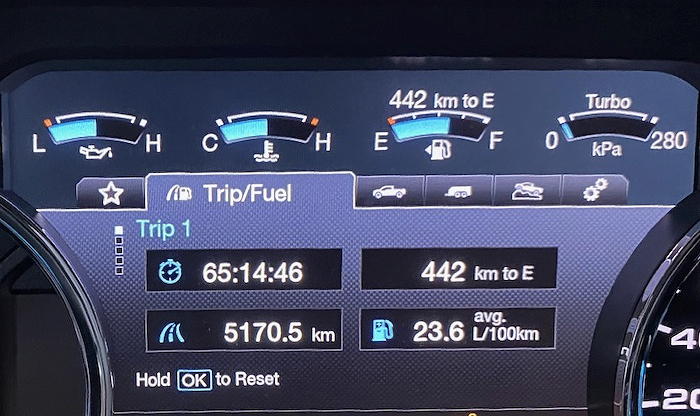
End of the COVID-19 Trip
That pretty much wraps up the entire trip. However, in Part 11, we’ll cover the joy of mud when we put the trailer back into the storage yard. We’ll also talk about life under quarantine, and we’ll have a few final thoughts on the entire experience. Join us!
This post was made public on March 29, 2020.

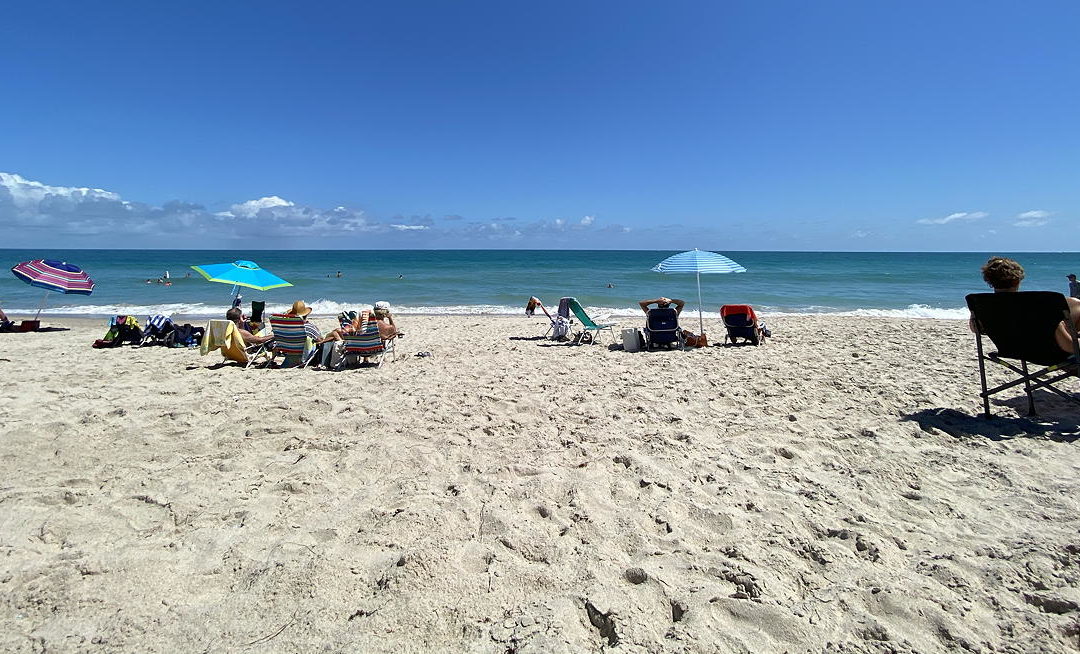
Recent Comments